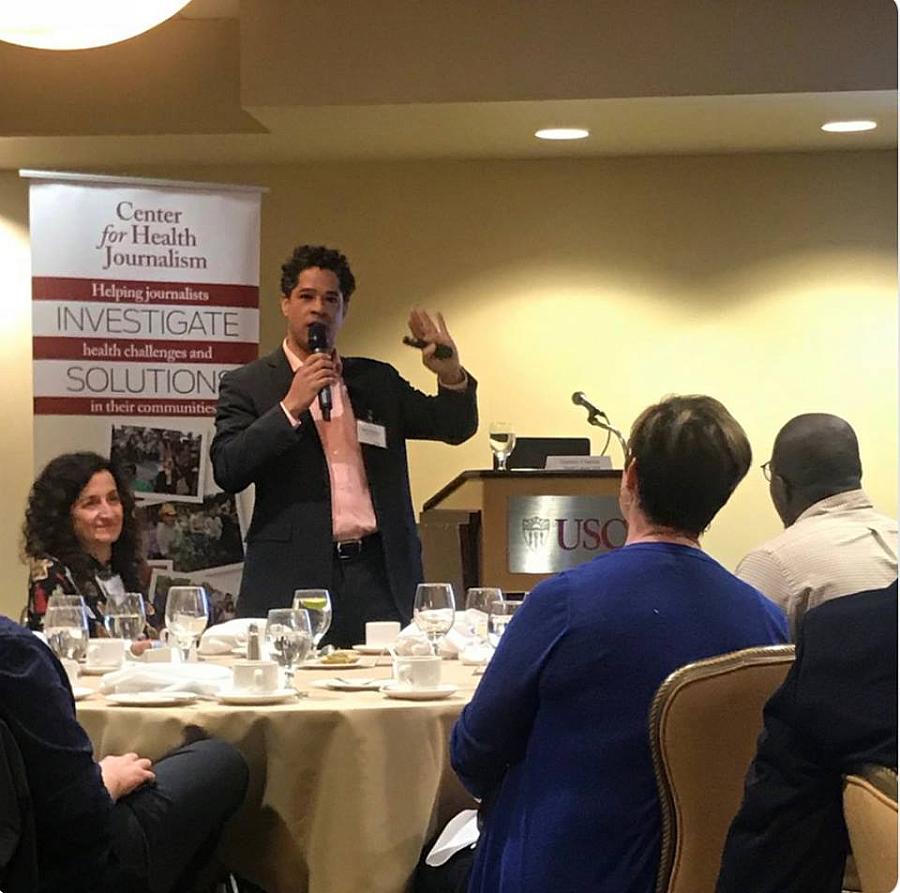Chief clinical officer of Health Leads implores journalists to go deeper on homelessness

Dr. Damon Francis delivers the keynote to fellows at the 2019 California Fellowship on Sunday.
(Photo by Chinyere Amobi/CHJ)
Dr. Damon Francis doesn’t shy away from sparring with a room full of journalists when he thinks the media is getting the story all wrong.
Delivering the keynote to nearly two dozen reporters at the 2019 California Fellowship, Francis took the profession to task for perpetuating damaging myths about homelessness while overlooking root causes and the historical context that explain today’s crisis.
Francis is an assistant clinical professor at UC San Franciso and serves as the chief clinical officer for Health Leads, an organization that helped pioneer the practice of addressing the social needs underlying many health problems — lack of housing, food insecurity, domestic violence, for example — through health care. Previously, he served as director of Health Care for the Homeless, an Alameda County program that coordinates health care and social services for unhoused residents.
It was there that he gained a deeper appreciation of the complex traumas many homeless people have suffered since childhood, trauma that often culminates in addiction, untreated mental health problems and homelessness. When providers at the Trust Health Center, a clinic Francis helped build, were able to help patients win their disability cases and secure a steady income, the results were eye-opening.
“We usually at that time could find people a place to live, and then all their health problems would go away,” Francis said. “I started to get really, really obsessed with housing.”
“Every problem that was hitting me in the face was the rental market,” he added. “The rental market is the issue. I cannot use any one-time allocation of money to help people find a place to rent for the rest of their life. They have to have an ongoing income of some sort, and there has to be housing available for them.”
But that underlying idea wasn’t showing up in the typical news story about homelessness in the county, and it’s fair to say Francis still harbors some acute resentment toward that kind of media coverage that he and his colleagues experienced at the time. (Short version: local officials are spending $xx dollars on the problem, but homelessness keeps getting worse.) “It hurts to do the work every day and then not get a good grade for it,” he said.
“Routinely, we would read newspaper articles about our work that said we were the ones that were ignoring the problem. Officials aren’t making the right decisions, officials aren’t spending the money in the right way.”
Francis wishes those stories made room for background on the decades-long drawdown of federal dollars for public housing, for instance. He sees the media as trafficking in myths of homelessness as an individual problem, rather than the product of socioeconomic forces and community decisions: “They’re homeless because they’re addicted. They’re homeless because of the trauma they’ve undergone. We need to fix the things that are inside their individual bodies and individual psyches. If these safety net services could all work together and fix these people, then they would be able to get jobs and actually get homes.”
At least that’s the wrongheaded narrative pushed by too many stories, according to Francis. The reality? “Perfectly coordinated services cannot overcome dramatic shortages of affordable housing.”
The two dozen journalists in the room took issue with parts of the critique. Their collective retort: Not every story can be a six-part narrative deep-dive. Sometimes you have two hours to turn a quick daily on homeless counts and funding trends. Plumping your story with historical background on changes in federal funding for housing that took place during the Carter Administration, as Francis suggested, will not endear you to your editor. Small-town papers are tasked with holding local officials to account, not Ben Carson, secretary of Housing and Urban Development. Also, we’re not sociologists or historians whose job it is to tease out the causal factors that precipitated today’s homelessness crisis.
“The business of journalism is immediate, it’s about what happening now,” said veteran reporter John Gonzales, who teaches journalism at Cal State Long Beach. “We’re not so good at looking back.”
And are journalists really overlooking the role of the housing market when discussing homelessness? “Here in Los Angeles, almost every single news story I see … there’s a direct through line to rental housing,” said Gary Walker, a reporter for Argonaut News.
While Francis may not always fully appreciate the exigencies of the daily newsroom on deadline, his plea for journalists to tell a fuller, deeper story of structural and historical forces when the opportunity arises is something most journalists would happily agree on. Assuming of course they can just pry a little more time from their editors in ever-shrinking newsrooms.
